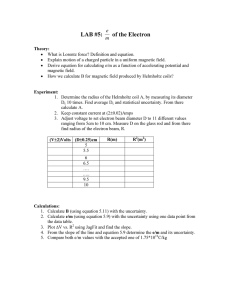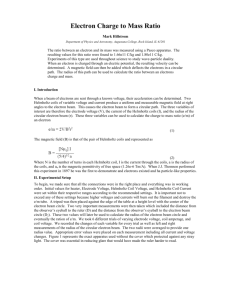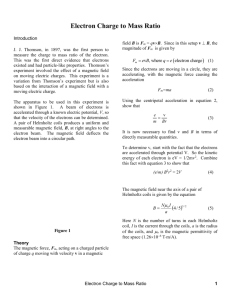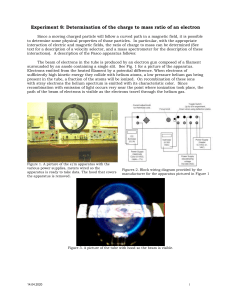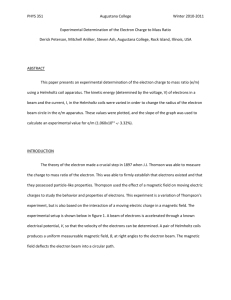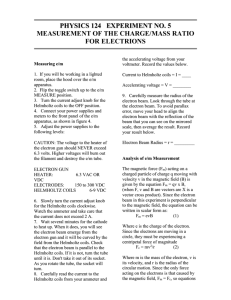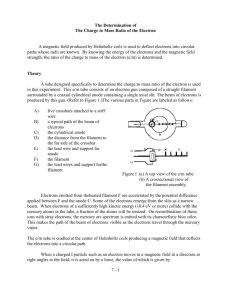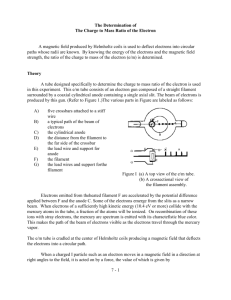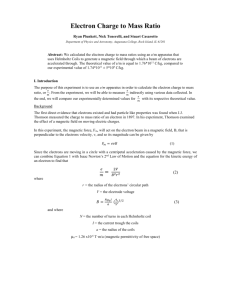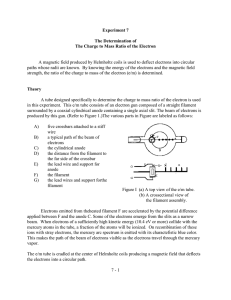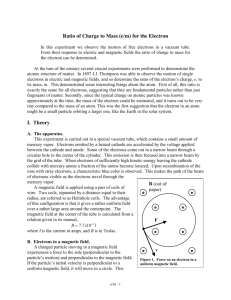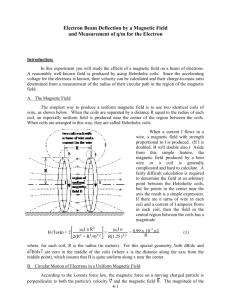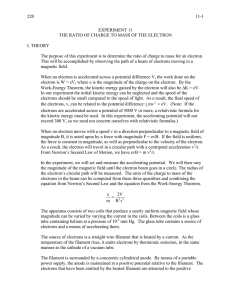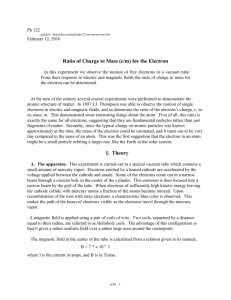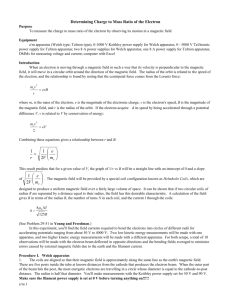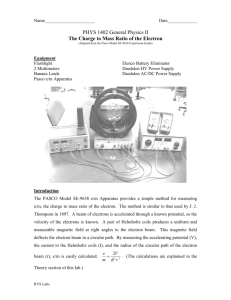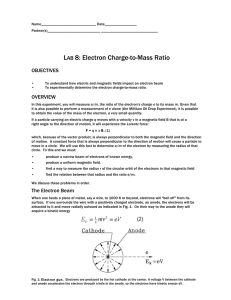casarotto em - Helios
advertisement
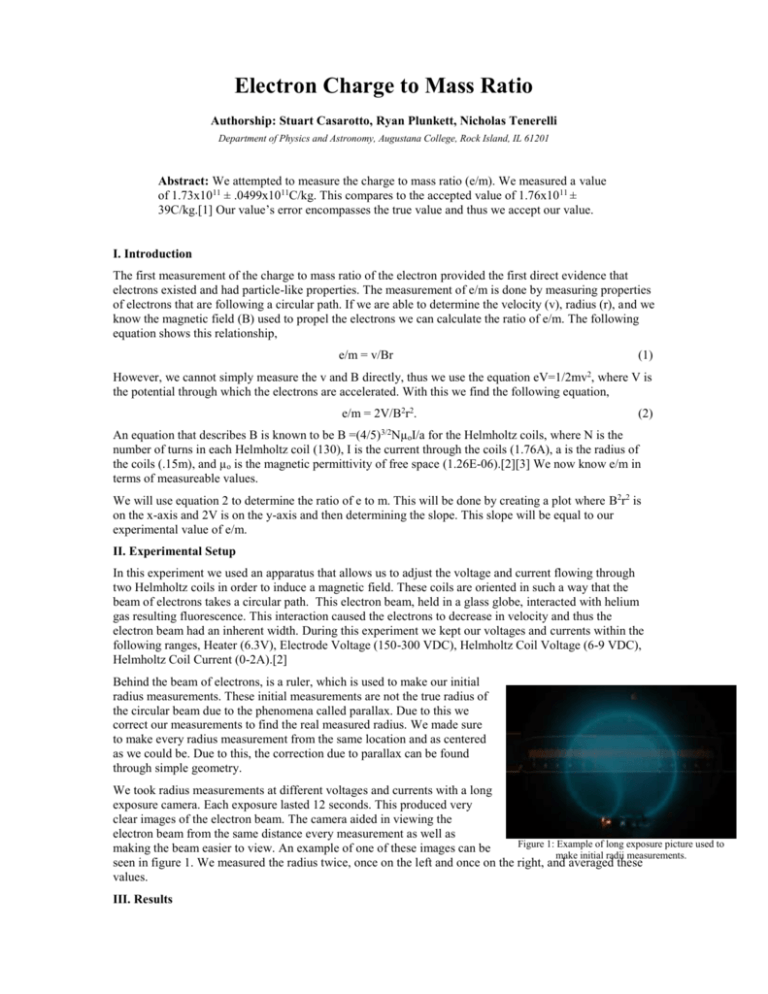
Electron Charge to Mass Ratio Authorship: Stuart Casarotto, Ryan Plunkett, Nicholas Tenerelli Department of Physics and Astronomy, Augustana College, Rock Island, IL 61201 Abstract: We attempted to measure the charge to mass ratio (e/m). We measured a value of 1.73x1011 ± .0499x1011C/kg. This compares to the accepted value of 1.76x1011 ± 39C/kg.[1] Our value’s error encompasses the true value and thus we accept our value. I. Introduction The first measurement of the charge to mass ratio of the electron provided the first direct evidence that electrons existed and had particle-like properties. The measurement of e/m is done by measuring properties of electrons that are following a circular path. If we are able to determine the velocity (v), radius (r), and we know the magnetic field (B) used to propel the electrons we can calculate the ratio of e/m. The following equation shows this relationship, e/m = v/Br (1) However, we cannot simply measure the v and B directly, thus we use the equation eV=1/2mv2, where V is the potential through which the electrons are accelerated. With this we find the following equation, e/m = 2V/B2r2. (2) 3/2 An equation that describes B is known to be B =(4/5) NµoI/a for the Helmholtz coils, where N is the number of turns in each Helmholtz coil (130), I is the current through the coils (1.76A), a is the radius of the coils (.15m), and µo is the magnetic permittivity of free space (1.26E-06).[2][3] We now know e/m in terms of measureable values. We will use equation 2 to determine the ratio of e to m. This will be done by creating a plot where B2r2 is on the x-axis and 2V is on the y-axis and then determining the slope. This slope will be equal to our experimental value of e/m. II. Experimental Setup In this experiment we used an apparatus that allows us to adjust the voltage and current flowing through two Helmholtz coils in order to induce a magnetic field. These coils are oriented in such a way that the beam of electrons takes a circular path. This electron beam, held in a glass globe, interacted with helium gas resulting fluorescence. This interaction caused the electrons to decrease in velocity and thus the electron beam had an inherent width. During this experiment we kept our voltages and currents within the following ranges, Heater (6.3V), Electrode Voltage (150-300 VDC), Helmholtz Coil Voltage (6-9 VDC), Helmholtz Coil Current (0-2A).[2] Behind the beam of electrons, is a ruler, which is used to make our initial radius measurements. These initial measurements are not the true radius of the circular beam due to the phenomena called parallax. Due to this we correct our measurements to find the real measured radius. We made sure to make every radius measurement from the same location and as centered as we could be. Due to this, the correction due to parallax can be found through simple geometry. We took radius measurements at different voltages and currents with a long exposure camera. Each exposure lasted 12 seconds. This produced very clear images of the electron beam. The camera aided in viewing the electron beam from the same distance every measurement as well as Figure 1: Example of long exposure picture used to making the beam easier to view. An example of one of these images can be make initial radii measurements. seen in figure 1. We measured the radius twice, once on the left and once on the right, and averaged these values. III. Results We created a plot where the x-axis is B2r2 and the y-axis is 2V (See Figure 2). Throughout the entire calculation process error was propagated and overlaid on the plot. The slope of the plot and its resulting error was then calculated. Precise calculations and measurements can be viewed in the attached excel document. Through this method we found that ratio of e/m to be 1.73x10 11 ± .0499x1011C/kg. This value and error agree with the accepted value of 1.76x10 11 ± 39C/kg.[1] Figure 2: Electron Charge to Mass Ratio. The slope and its error describe our experimental value of e/m. IV. Discussion The use of the long exposure camera made this experiment efficient and accurate. It allowed us to very accurately make radius measurements and being certain we were taking the measurements from the same location. The inherent width to the electron beam was taken into account in the error. Overall this experiment was straightforward and with the care we took resulted in a very accurate measure of e/m. References [1] "Mass-to-charge Ratio." Wikipedia. Wikimedia Foundation, 24 Dec. 2013. Web. 14 Jan. 2014. [2] “Electron charge to Mass Ratio” handout [3] Apparatus User Manual
